Comprehensive Report: Time Value of Money in Finance
VerifiedAdded on 2022/09/12
|14
|4205
|19
Report
AI Summary
This report provides a detailed overview of the Time Value of Money (TVM), a fundamental concept in finance. It introduces the core idea that money's value changes over time due to its earning potential. The report explores the history of TVM, its key components such as present value, future value, interest rates, and annuities, and the factors influencing it. It delves into the practical applications of TVM in investment decisions, financial planning, and economic analysis. The report also highlights the importance of understanding opportunity cost and its relation to TVM. The report further discusses the significance of interest rates, compounding, and the role of TVM in making informed financial choices. This report is a valuable resource for understanding the principles of TVM and its relevance in various financial contexts.
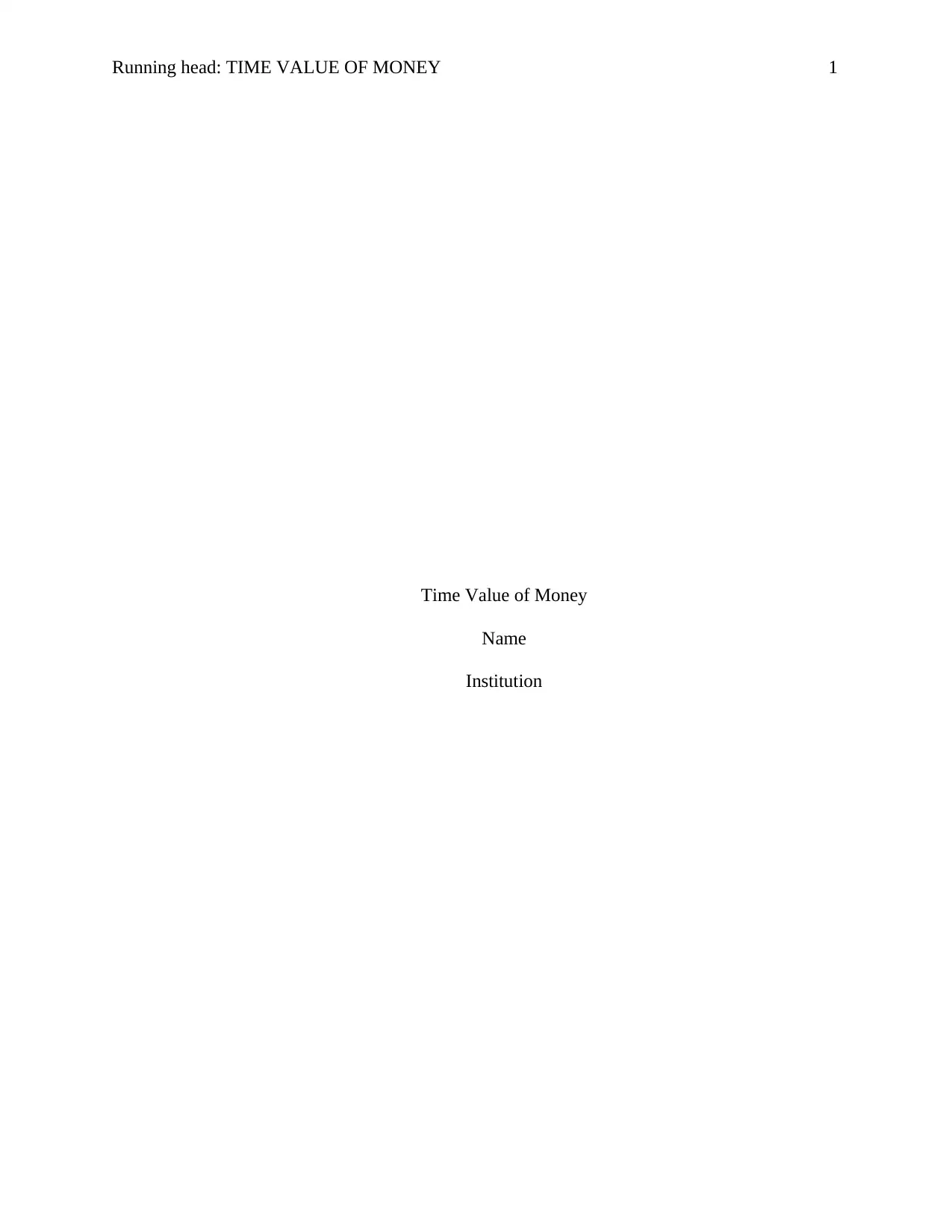
Running head: TIME VALUE OF MONEY 1
Time Value of Money
Name
Institution
Time Value of Money
Name
Institution
Paraphrase This Document
Need a fresh take? Get an instant paraphrase of this document with our AI Paraphraser
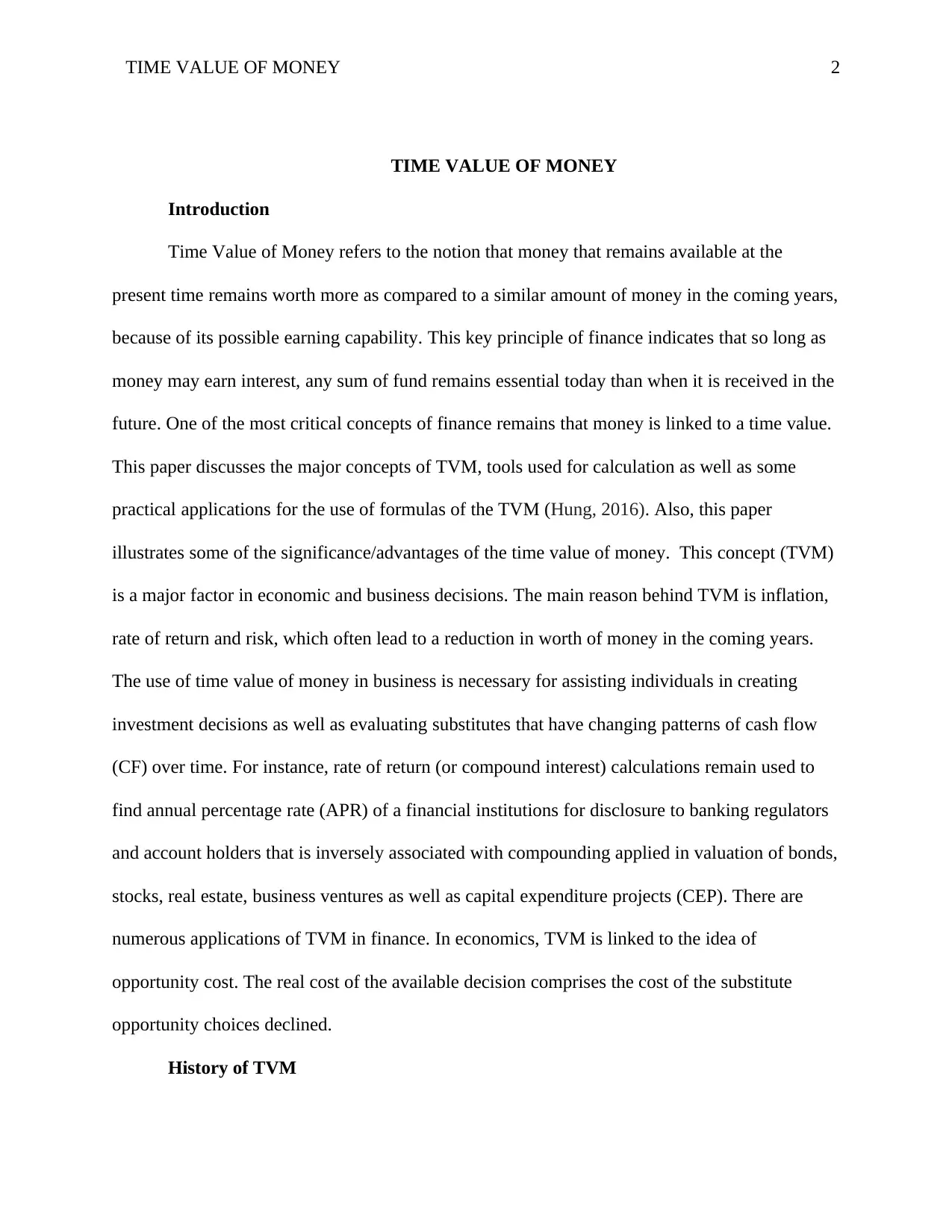
TIME VALUE OF MONEY 2
TIME VALUE OF MONEY
Introduction
Time Value of Money refers to the notion that money that remains available at the
present time remains worth more as compared to a similar amount of money in the coming years,
because of its possible earning capability. This key principle of finance indicates that so long as
money may earn interest, any sum of fund remains essential today than when it is received in the
future. One of the most critical concepts of finance remains that money is linked to a time value.
This paper discusses the major concepts of TVM, tools used for calculation as well as some
practical applications for the use of formulas of the TVM (Hung, 2016). Also, this paper
illustrates some of the significance/advantages of the time value of money. This concept (TVM)
is a major factor in economic and business decisions. The main reason behind TVM is inflation,
rate of return and risk, which often lead to a reduction in worth of money in the coming years.
The use of time value of money in business is necessary for assisting individuals in creating
investment decisions as well as evaluating substitutes that have changing patterns of cash flow
(CF) over time. For instance, rate of return (or compound interest) calculations remain used to
find annual percentage rate (APR) of a financial institutions for disclosure to banking regulators
and account holders that is inversely associated with compounding applied in valuation of bonds,
stocks, real estate, business ventures as well as capital expenditure projects (CEP). There are
numerous applications of TVM in finance. In economics, TVM is linked to the idea of
opportunity cost. The real cost of the available decision comprises the cost of the substitute
opportunity choices declined.
History of TVM
TIME VALUE OF MONEY
Introduction
Time Value of Money refers to the notion that money that remains available at the
present time remains worth more as compared to a similar amount of money in the coming years,
because of its possible earning capability. This key principle of finance indicates that so long as
money may earn interest, any sum of fund remains essential today than when it is received in the
future. One of the most critical concepts of finance remains that money is linked to a time value.
This paper discusses the major concepts of TVM, tools used for calculation as well as some
practical applications for the use of formulas of the TVM (Hung, 2016). Also, this paper
illustrates some of the significance/advantages of the time value of money. This concept (TVM)
is a major factor in economic and business decisions. The main reason behind TVM is inflation,
rate of return and risk, which often lead to a reduction in worth of money in the coming years.
The use of time value of money in business is necessary for assisting individuals in creating
investment decisions as well as evaluating substitutes that have changing patterns of cash flow
(CF) over time. For instance, rate of return (or compound interest) calculations remain used to
find annual percentage rate (APR) of a financial institutions for disclosure to banking regulators
and account holders that is inversely associated with compounding applied in valuation of bonds,
stocks, real estate, business ventures as well as capital expenditure projects (CEP). There are
numerous applications of TVM in finance. In economics, TVM is linked to the idea of
opportunity cost. The real cost of the available decision comprises the cost of the substitute
opportunity choices declined.
History of TVM
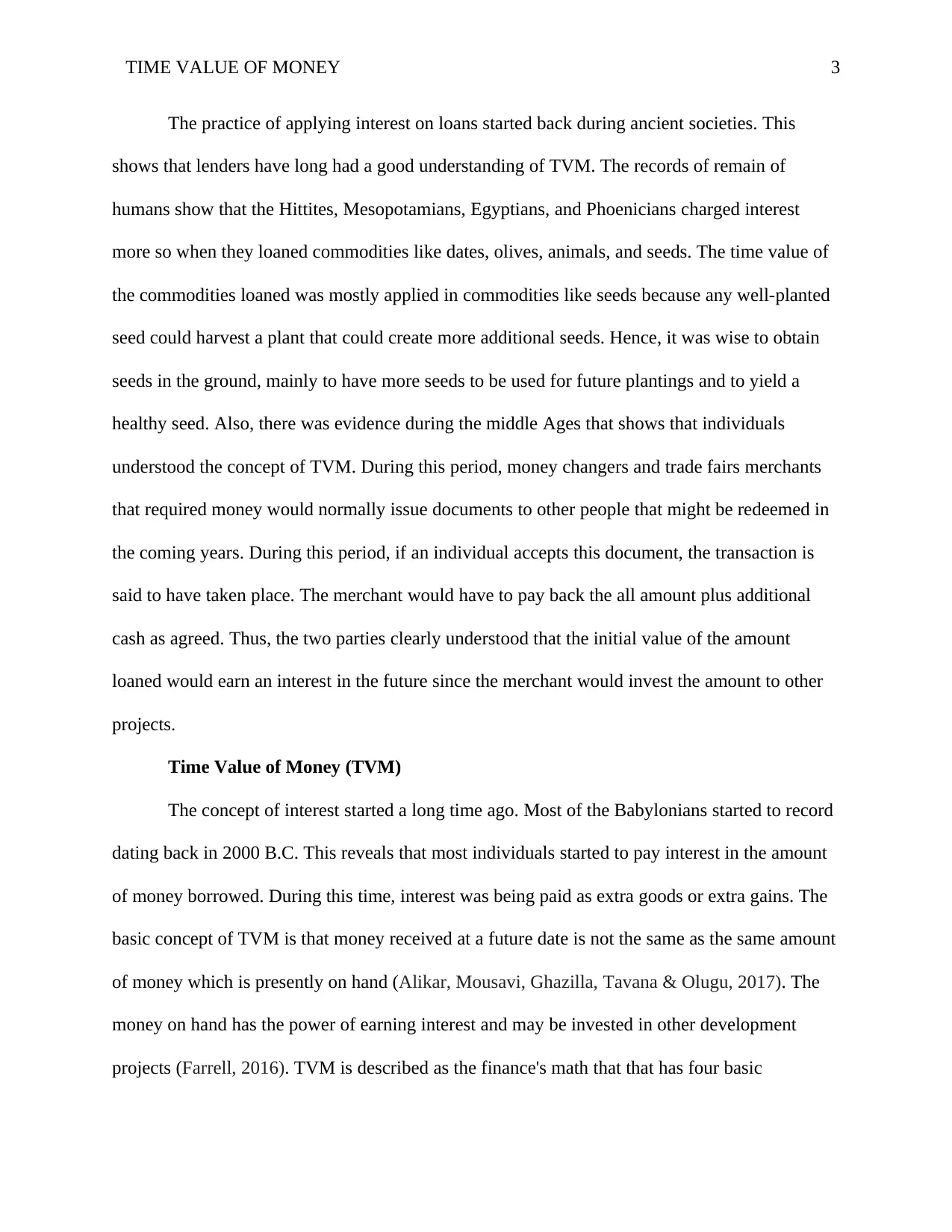
TIME VALUE OF MONEY 3
The practice of applying interest on loans started back during ancient societies. This
shows that lenders have long had a good understanding of TVM. The records of remain of
humans show that the Hittites, Mesopotamians, Egyptians, and Phoenicians charged interest
more so when they loaned commodities like dates, olives, animals, and seeds. The time value of
the commodities loaned was mostly applied in commodities like seeds because any well-planted
seed could harvest a plant that could create more additional seeds. Hence, it was wise to obtain
seeds in the ground, mainly to have more seeds to be used for future plantings and to yield a
healthy seed. Also, there was evidence during the middle Ages that shows that individuals
understood the concept of TVM. During this period, money changers and trade fairs merchants
that required money would normally issue documents to other people that might be redeemed in
the coming years. During this period, if an individual accepts this document, the transaction is
said to have taken place. The merchant would have to pay back the all amount plus additional
cash as agreed. Thus, the two parties clearly understood that the initial value of the amount
loaned would earn an interest in the future since the merchant would invest the amount to other
projects.
Time Value of Money (TVM)
The concept of interest started a long time ago. Most of the Babylonians started to record
dating back in 2000 B.C. This reveals that most individuals started to pay interest in the amount
of money borrowed. During this time, interest was being paid as extra goods or extra gains. The
basic concept of TVM is that money received at a future date is not the same as the same amount
of money which is presently on hand (Alikar, Mousavi, Ghazilla, Tavana & Olugu, 2017). The
money on hand has the power of earning interest and may be invested in other development
projects (Farrell, 2016). TVM is described as the finance's math that that has four basic
The practice of applying interest on loans started back during ancient societies. This
shows that lenders have long had a good understanding of TVM. The records of remain of
humans show that the Hittites, Mesopotamians, Egyptians, and Phoenicians charged interest
more so when they loaned commodities like dates, olives, animals, and seeds. The time value of
the commodities loaned was mostly applied in commodities like seeds because any well-planted
seed could harvest a plant that could create more additional seeds. Hence, it was wise to obtain
seeds in the ground, mainly to have more seeds to be used for future plantings and to yield a
healthy seed. Also, there was evidence during the middle Ages that shows that individuals
understood the concept of TVM. During this period, money changers and trade fairs merchants
that required money would normally issue documents to other people that might be redeemed in
the coming years. During this period, if an individual accepts this document, the transaction is
said to have taken place. The merchant would have to pay back the all amount plus additional
cash as agreed. Thus, the two parties clearly understood that the initial value of the amount
loaned would earn an interest in the future since the merchant would invest the amount to other
projects.
Time Value of Money (TVM)
The concept of interest started a long time ago. Most of the Babylonians started to record
dating back in 2000 B.C. This reveals that most individuals started to pay interest in the amount
of money borrowed. During this time, interest was being paid as extra goods or extra gains. The
basic concept of TVM is that money received at a future date is not the same as the same amount
of money which is presently on hand (Alikar, Mousavi, Ghazilla, Tavana & Olugu, 2017). The
money on hand has the power of earning interest and may be invested in other development
projects (Farrell, 2016). TVM is described as the finance's math that that has four basic
⊘ This is a preview!⊘
Do you want full access?
Subscribe today to unlock all pages.

Trusted by 1+ million students worldwide
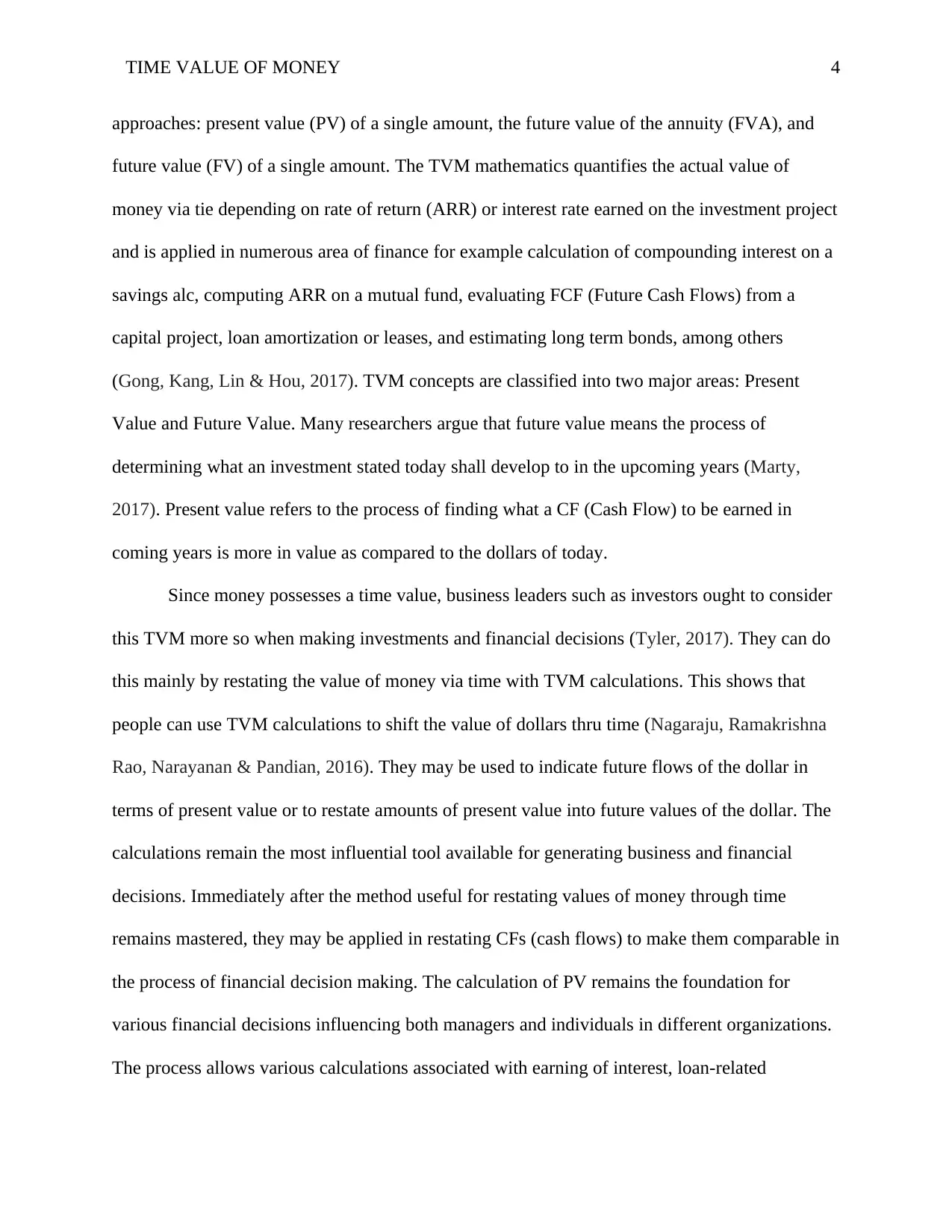
TIME VALUE OF MONEY 4
approaches: present value (PV) of a single amount, the future value of the annuity (FVA), and
future value (FV) of a single amount. The TVM mathematics quantifies the actual value of
money via tie depending on rate of return (ARR) or interest rate earned on the investment project
and is applied in numerous area of finance for example calculation of compounding interest on a
savings alc, computing ARR on a mutual fund, evaluating FCF (Future Cash Flows) from a
capital project, loan amortization or leases, and estimating long term bonds, among others
(Gong, Kang, Lin & Hou, 2017). TVM concepts are classified into two major areas: Present
Value and Future Value. Many researchers argue that future value means the process of
determining what an investment stated today shall develop to in the upcoming years (Marty,
2017). Present value refers to the process of finding what a CF (Cash Flow) to be earned in
coming years is more in value as compared to the dollars of today.
Since money possesses a time value, business leaders such as investors ought to consider
this TVM more so when making investments and financial decisions (Tyler, 2017). They can do
this mainly by restating the value of money via time with TVM calculations. This shows that
people can use TVM calculations to shift the value of dollars thru time (Nagaraju, Ramakrishna
Rao, Narayanan & Pandian, 2016). They may be used to indicate future flows of the dollar in
terms of present value or to restate amounts of present value into future values of the dollar. The
calculations remain the most influential tool available for generating business and financial
decisions. Immediately after the method useful for restating values of money through time
remains mastered, they may be applied in restating CFs (cash flows) to make them comparable in
the process of financial decision making. The calculation of PV remains the foundation for
various financial decisions influencing both managers and individuals in different organizations.
The process allows various calculations associated with earning of interest, loan-related
approaches: present value (PV) of a single amount, the future value of the annuity (FVA), and
future value (FV) of a single amount. The TVM mathematics quantifies the actual value of
money via tie depending on rate of return (ARR) or interest rate earned on the investment project
and is applied in numerous area of finance for example calculation of compounding interest on a
savings alc, computing ARR on a mutual fund, evaluating FCF (Future Cash Flows) from a
capital project, loan amortization or leases, and estimating long term bonds, among others
(Gong, Kang, Lin & Hou, 2017). TVM concepts are classified into two major areas: Present
Value and Future Value. Many researchers argue that future value means the process of
determining what an investment stated today shall develop to in the upcoming years (Marty,
2017). Present value refers to the process of finding what a CF (Cash Flow) to be earned in
coming years is more in value as compared to the dollars of today.
Since money possesses a time value, business leaders such as investors ought to consider
this TVM more so when making investments and financial decisions (Tyler, 2017). They can do
this mainly by restating the value of money via time with TVM calculations. This shows that
people can use TVM calculations to shift the value of dollars thru time (Nagaraju, Ramakrishna
Rao, Narayanan & Pandian, 2016). They may be used to indicate future flows of the dollar in
terms of present value or to restate amounts of present value into future values of the dollar. The
calculations remain the most influential tool available for generating business and financial
decisions. Immediately after the method useful for restating values of money through time
remains mastered, they may be applied in restating CFs (cash flows) to make them comparable in
the process of financial decision making. The calculation of PV remains the foundation for
various financial decisions influencing both managers and individuals in different organizations.
The process allows various calculations associated with earning of interest, loan-related
Paraphrase This Document
Need a fresh take? Get an instant paraphrase of this document with our AI Paraphraser
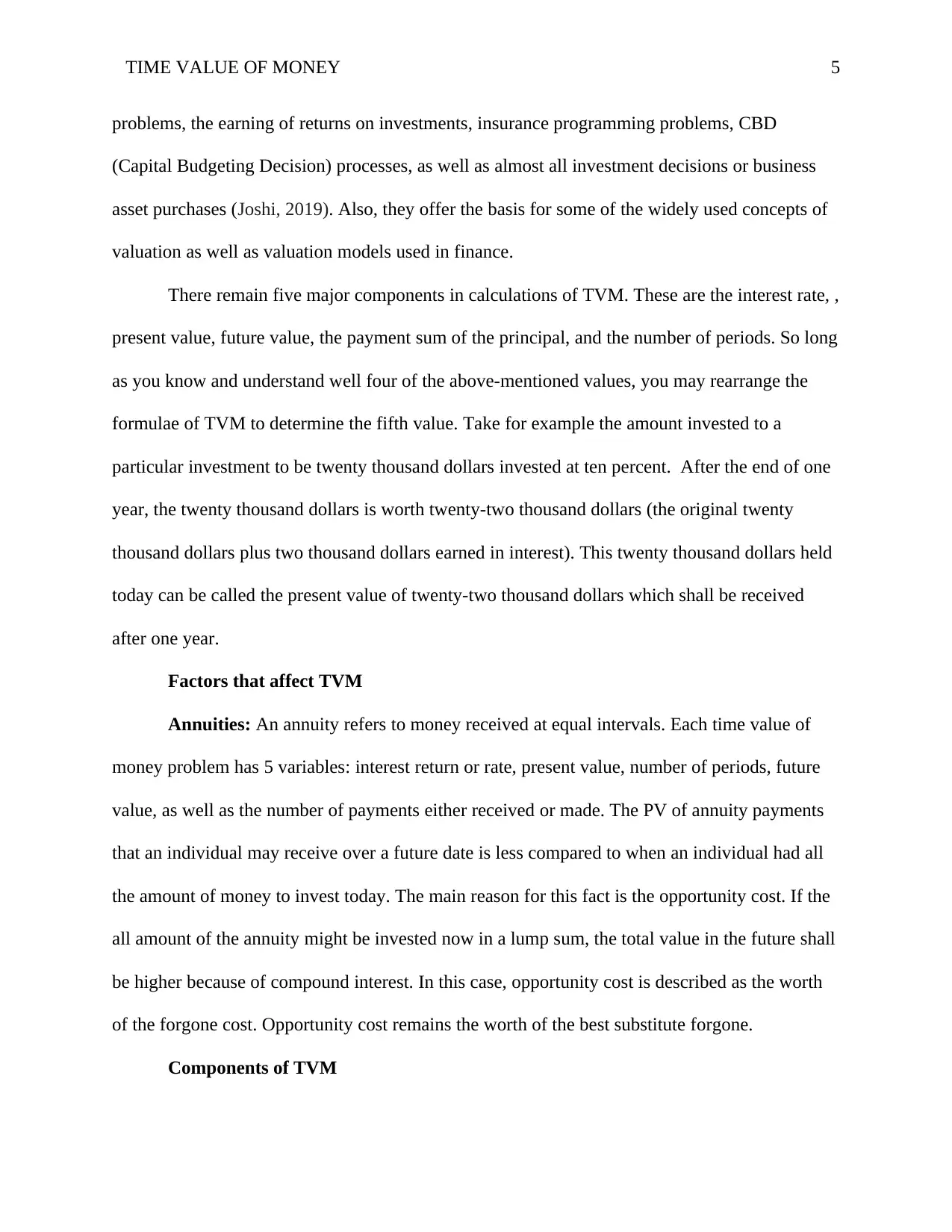
TIME VALUE OF MONEY 5
problems, the earning of returns on investments, insurance programming problems, CBD
(Capital Budgeting Decision) processes, as well as almost all investment decisions or business
asset purchases (Joshi, 2019). Also, they offer the basis for some of the widely used concepts of
valuation as well as valuation models used in finance.
There remain five major components in calculations of TVM. These are the interest rate, ,
present value, future value, the payment sum of the principal, and the number of periods. So long
as you know and understand well four of the above-mentioned values, you may rearrange the
formulae of TVM to determine the fifth value. Take for example the amount invested to a
particular investment to be twenty thousand dollars invested at ten percent. After the end of one
year, the twenty thousand dollars is worth twenty-two thousand dollars (the original twenty
thousand dollars plus two thousand dollars earned in interest). This twenty thousand dollars held
today can be called the present value of twenty-two thousand dollars which shall be received
after one year.
Factors that affect TVM
Annuities: An annuity refers to money received at equal intervals. Each time value of
money problem has 5 variables: interest return or rate, present value, number of periods, future
value, as well as the number of payments either received or made. The PV of annuity payments
that an individual may receive over a future date is less compared to when an individual had all
the amount of money to invest today. The main reason for this fact is the opportunity cost. If the
all amount of the annuity might be invested now in a lump sum, the total value in the future shall
be higher because of compound interest. In this case, opportunity cost is described as the worth
of the forgone cost. Opportunity cost remains the worth of the best substitute forgone.
Components of TVM
problems, the earning of returns on investments, insurance programming problems, CBD
(Capital Budgeting Decision) processes, as well as almost all investment decisions or business
asset purchases (Joshi, 2019). Also, they offer the basis for some of the widely used concepts of
valuation as well as valuation models used in finance.
There remain five major components in calculations of TVM. These are the interest rate, ,
present value, future value, the payment sum of the principal, and the number of periods. So long
as you know and understand well four of the above-mentioned values, you may rearrange the
formulae of TVM to determine the fifth value. Take for example the amount invested to a
particular investment to be twenty thousand dollars invested at ten percent. After the end of one
year, the twenty thousand dollars is worth twenty-two thousand dollars (the original twenty
thousand dollars plus two thousand dollars earned in interest). This twenty thousand dollars held
today can be called the present value of twenty-two thousand dollars which shall be received
after one year.
Factors that affect TVM
Annuities: An annuity refers to money received at equal intervals. Each time value of
money problem has 5 variables: interest return or rate, present value, number of periods, future
value, as well as the number of payments either received or made. The PV of annuity payments
that an individual may receive over a future date is less compared to when an individual had all
the amount of money to invest today. The main reason for this fact is the opportunity cost. If the
all amount of the annuity might be invested now in a lump sum, the total value in the future shall
be higher because of compound interest. In this case, opportunity cost is described as the worth
of the forgone cost. Opportunity cost remains the worth of the best substitute forgone.
Components of TVM
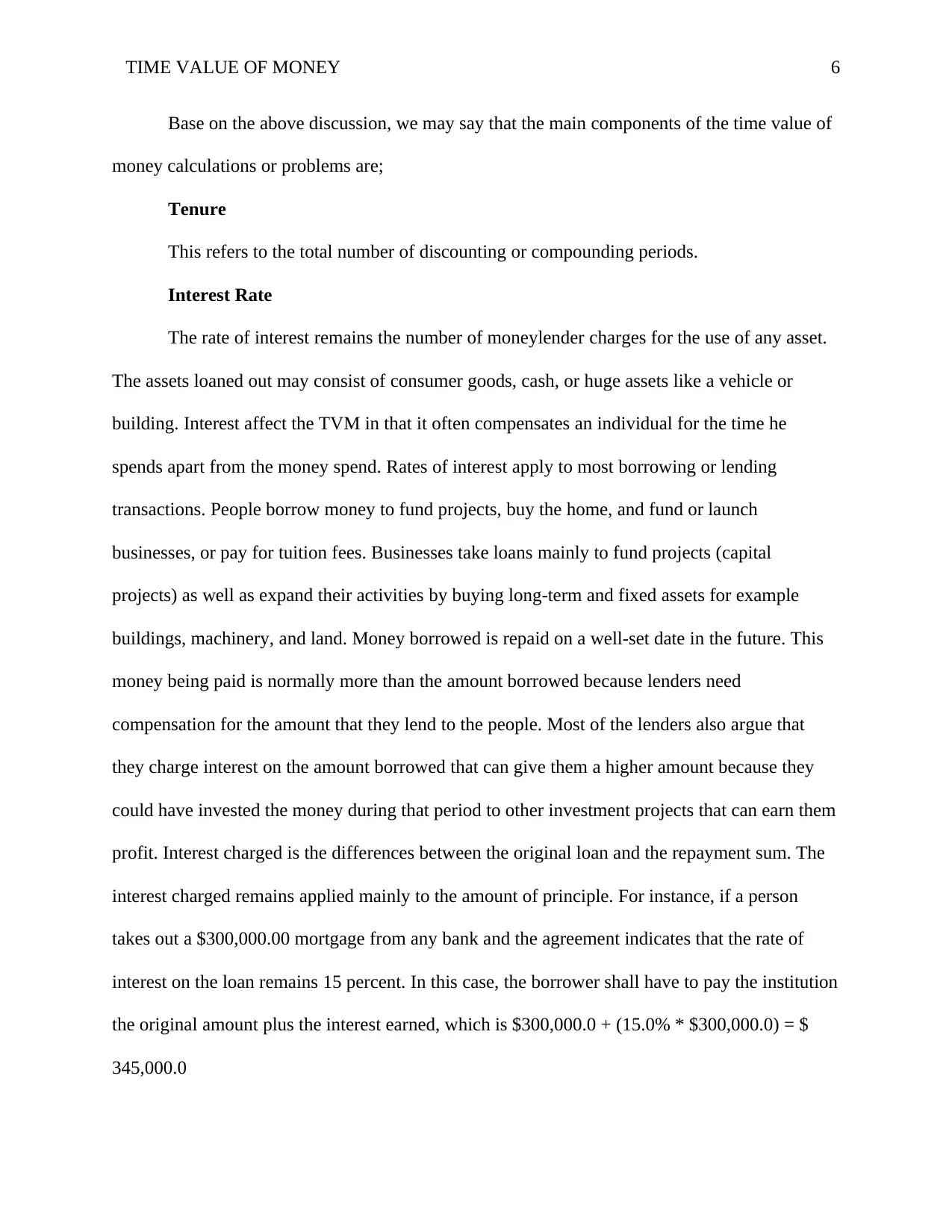
TIME VALUE OF MONEY 6
Base on the above discussion, we may say that the main components of the time value of
money calculations or problems are;
Tenure
This refers to the total number of discounting or compounding periods.
Interest Rate
The rate of interest remains the number of moneylender charges for the use of any asset.
The assets loaned out may consist of consumer goods, cash, or huge assets like a vehicle or
building. Interest affect the TVM in that it often compensates an individual for the time he
spends apart from the money spend. Rates of interest apply to most borrowing or lending
transactions. People borrow money to fund projects, buy the home, and fund or launch
businesses, or pay for tuition fees. Businesses take loans mainly to fund projects (capital
projects) as well as expand their activities by buying long-term and fixed assets for example
buildings, machinery, and land. Money borrowed is repaid on a well-set date in the future. This
money being paid is normally more than the amount borrowed because lenders need
compensation for the amount that they lend to the people. Most of the lenders also argue that
they charge interest on the amount borrowed that can give them a higher amount because they
could have invested the money during that period to other investment projects that can earn them
profit. Interest charged is the differences between the original loan and the repayment sum. The
interest charged remains applied mainly to the amount of principle. For instance, if a person
takes out a $300,000.00 mortgage from any bank and the agreement indicates that the rate of
interest on the loan remains 15 percent. In this case, the borrower shall have to pay the institution
the original amount plus the interest earned, which is $300,000.0 + (15.0% * $300,000.0) = $
345,000.0
Base on the above discussion, we may say that the main components of the time value of
money calculations or problems are;
Tenure
This refers to the total number of discounting or compounding periods.
Interest Rate
The rate of interest remains the number of moneylender charges for the use of any asset.
The assets loaned out may consist of consumer goods, cash, or huge assets like a vehicle or
building. Interest affect the TVM in that it often compensates an individual for the time he
spends apart from the money spend. Rates of interest apply to most borrowing or lending
transactions. People borrow money to fund projects, buy the home, and fund or launch
businesses, or pay for tuition fees. Businesses take loans mainly to fund projects (capital
projects) as well as expand their activities by buying long-term and fixed assets for example
buildings, machinery, and land. Money borrowed is repaid on a well-set date in the future. This
money being paid is normally more than the amount borrowed because lenders need
compensation for the amount that they lend to the people. Most of the lenders also argue that
they charge interest on the amount borrowed that can give them a higher amount because they
could have invested the money during that period to other investment projects that can earn them
profit. Interest charged is the differences between the original loan and the repayment sum. The
interest charged remains applied mainly to the amount of principle. For instance, if a person
takes out a $300,000.00 mortgage from any bank and the agreement indicates that the rate of
interest on the loan remains 15 percent. In this case, the borrower shall have to pay the institution
the original amount plus the interest earned, which is $300,000.0 + (15.0% * $300,000.0) = $
345,000.0
⊘ This is a preview!⊘
Do you want full access?
Subscribe today to unlock all pages.

Trusted by 1+ million students worldwide
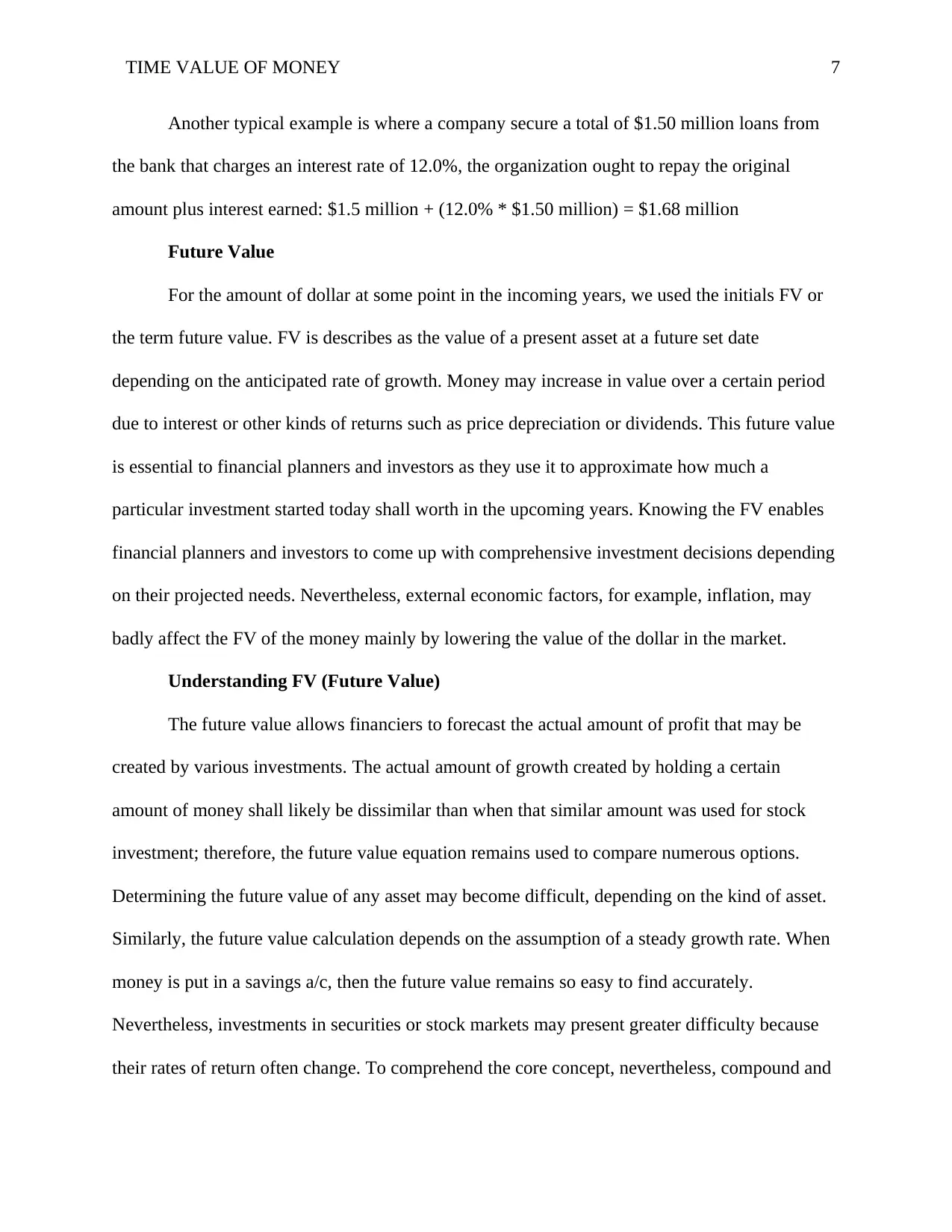
TIME VALUE OF MONEY 7
Another typical example is where a company secure a total of $1.50 million loans from
the bank that charges an interest rate of 12.0%, the organization ought to repay the original
amount plus interest earned: $1.5 million + (12.0% * $1.50 million) = $1.68 million
Future Value
For the amount of dollar at some point in the incoming years, we used the initials FV or
the term future value. FV is describes as the value of a present asset at a future set date
depending on the anticipated rate of growth. Money may increase in value over a certain period
due to interest or other kinds of returns such as price depreciation or dividends. This future value
is essential to financial planners and investors as they use it to approximate how much a
particular investment started today shall worth in the upcoming years. Knowing the FV enables
financial planners and investors to come up with comprehensive investment decisions depending
on their projected needs. Nevertheless, external economic factors, for example, inflation, may
badly affect the FV of the money mainly by lowering the value of the dollar in the market.
Understanding FV (Future Value)
The future value allows financiers to forecast the actual amount of profit that may be
created by various investments. The actual amount of growth created by holding a certain
amount of money shall likely be dissimilar than when that similar amount was used for stock
investment; therefore, the future value equation remains used to compare numerous options.
Determining the future value of any asset may become difficult, depending on the kind of asset.
Similarly, the future value calculation depends on the assumption of a steady growth rate. When
money is put in a savings a/c, then the future value remains so easy to find accurately.
Nevertheless, investments in securities or stock markets may present greater difficulty because
their rates of return often change. To comprehend the core concept, nevertheless, compound and
Another typical example is where a company secure a total of $1.50 million loans from
the bank that charges an interest rate of 12.0%, the organization ought to repay the original
amount plus interest earned: $1.5 million + (12.0% * $1.50 million) = $1.68 million
Future Value
For the amount of dollar at some point in the incoming years, we used the initials FV or
the term future value. FV is describes as the value of a present asset at a future set date
depending on the anticipated rate of growth. Money may increase in value over a certain period
due to interest or other kinds of returns such as price depreciation or dividends. This future value
is essential to financial planners and investors as they use it to approximate how much a
particular investment started today shall worth in the upcoming years. Knowing the FV enables
financial planners and investors to come up with comprehensive investment decisions depending
on their projected needs. Nevertheless, external economic factors, for example, inflation, may
badly affect the FV of the money mainly by lowering the value of the dollar in the market.
Understanding FV (Future Value)
The future value allows financiers to forecast the actual amount of profit that may be
created by various investments. The actual amount of growth created by holding a certain
amount of money shall likely be dissimilar than when that similar amount was used for stock
investment; therefore, the future value equation remains used to compare numerous options.
Determining the future value of any asset may become difficult, depending on the kind of asset.
Similarly, the future value calculation depends on the assumption of a steady growth rate. When
money is put in a savings a/c, then the future value remains so easy to find accurately.
Nevertheless, investments in securities or stock markets may present greater difficulty because
their rates of return often change. To comprehend the core concept, nevertheless, compound and
Paraphrase This Document
Need a fresh take? Get an instant paraphrase of this document with our AI Paraphraser
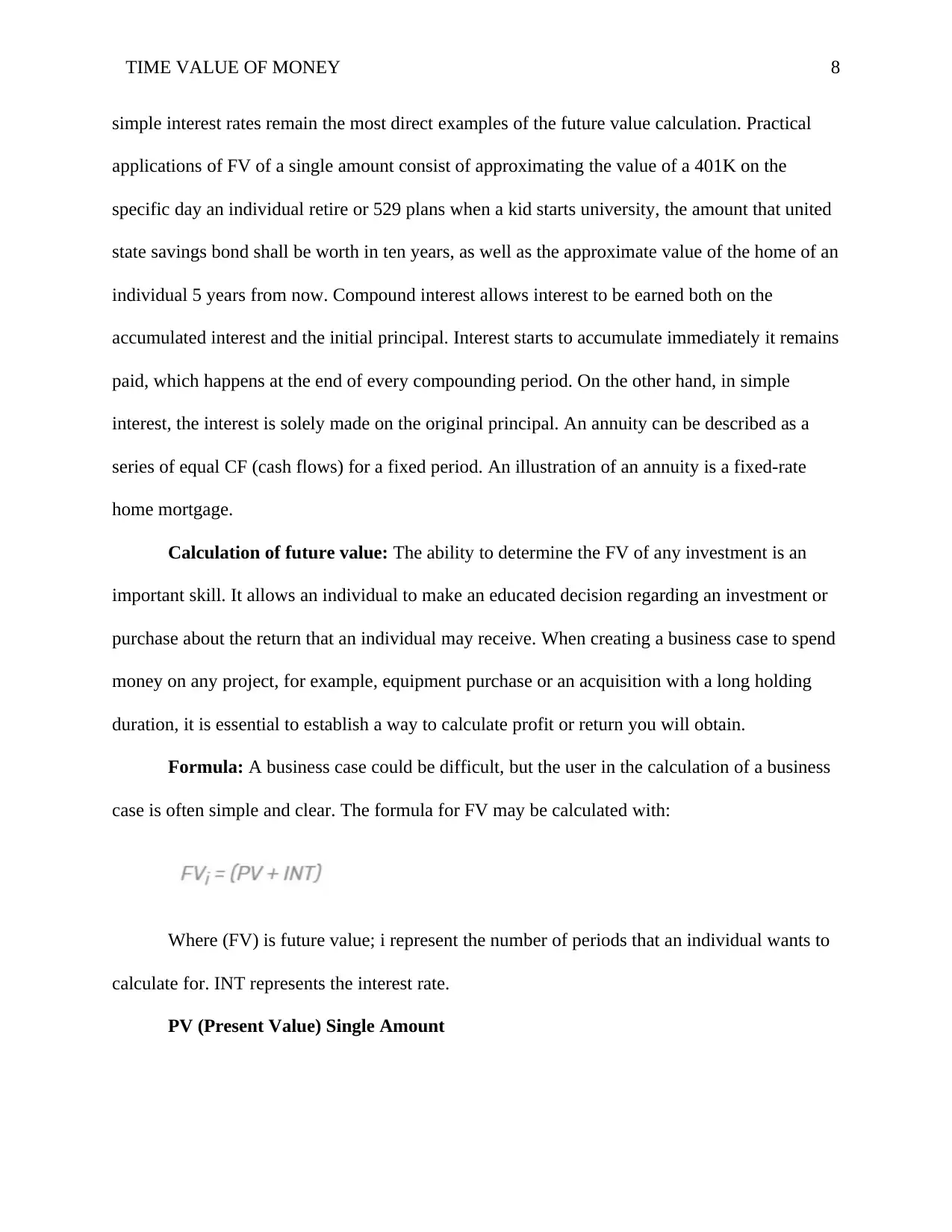
TIME VALUE OF MONEY 8
simple interest rates remain the most direct examples of the future value calculation. Practical
applications of FV of a single amount consist of approximating the value of a 401K on the
specific day an individual retire or 529 plans when a kid starts university, the amount that united
state savings bond shall be worth in ten years, as well as the approximate value of the home of an
individual 5 years from now. Compound interest allows interest to be earned both on the
accumulated interest and the initial principal. Interest starts to accumulate immediately it remains
paid, which happens at the end of every compounding period. On the other hand, in simple
interest, the interest is solely made on the original principal. An annuity can be described as a
series of equal CF (cash flows) for a fixed period. An illustration of an annuity is a fixed-rate
home mortgage.
Calculation of future value: The ability to determine the FV of any investment is an
important skill. It allows an individual to make an educated decision regarding an investment or
purchase about the return that an individual may receive. When creating a business case to spend
money on any project, for example, equipment purchase or an acquisition with a long holding
duration, it is essential to establish a way to calculate profit or return you will obtain.
Formula: A business case could be difficult, but the user in the calculation of a business
case is often simple and clear. The formula for FV may be calculated with:
Where (FV) is future value; i represent the number of periods that an individual wants to
calculate for. INT represents the interest rate.
PV (Present Value) Single Amount
simple interest rates remain the most direct examples of the future value calculation. Practical
applications of FV of a single amount consist of approximating the value of a 401K on the
specific day an individual retire or 529 plans when a kid starts university, the amount that united
state savings bond shall be worth in ten years, as well as the approximate value of the home of an
individual 5 years from now. Compound interest allows interest to be earned both on the
accumulated interest and the initial principal. Interest starts to accumulate immediately it remains
paid, which happens at the end of every compounding period. On the other hand, in simple
interest, the interest is solely made on the original principal. An annuity can be described as a
series of equal CF (cash flows) for a fixed period. An illustration of an annuity is a fixed-rate
home mortgage.
Calculation of future value: The ability to determine the FV of any investment is an
important skill. It allows an individual to make an educated decision regarding an investment or
purchase about the return that an individual may receive. When creating a business case to spend
money on any project, for example, equipment purchase or an acquisition with a long holding
duration, it is essential to establish a way to calculate profit or return you will obtain.
Formula: A business case could be difficult, but the user in the calculation of a business
case is often simple and clear. The formula for FV may be calculated with:
Where (FV) is future value; i represent the number of periods that an individual wants to
calculate for. INT represents the interest rate.
PV (Present Value) Single Amount
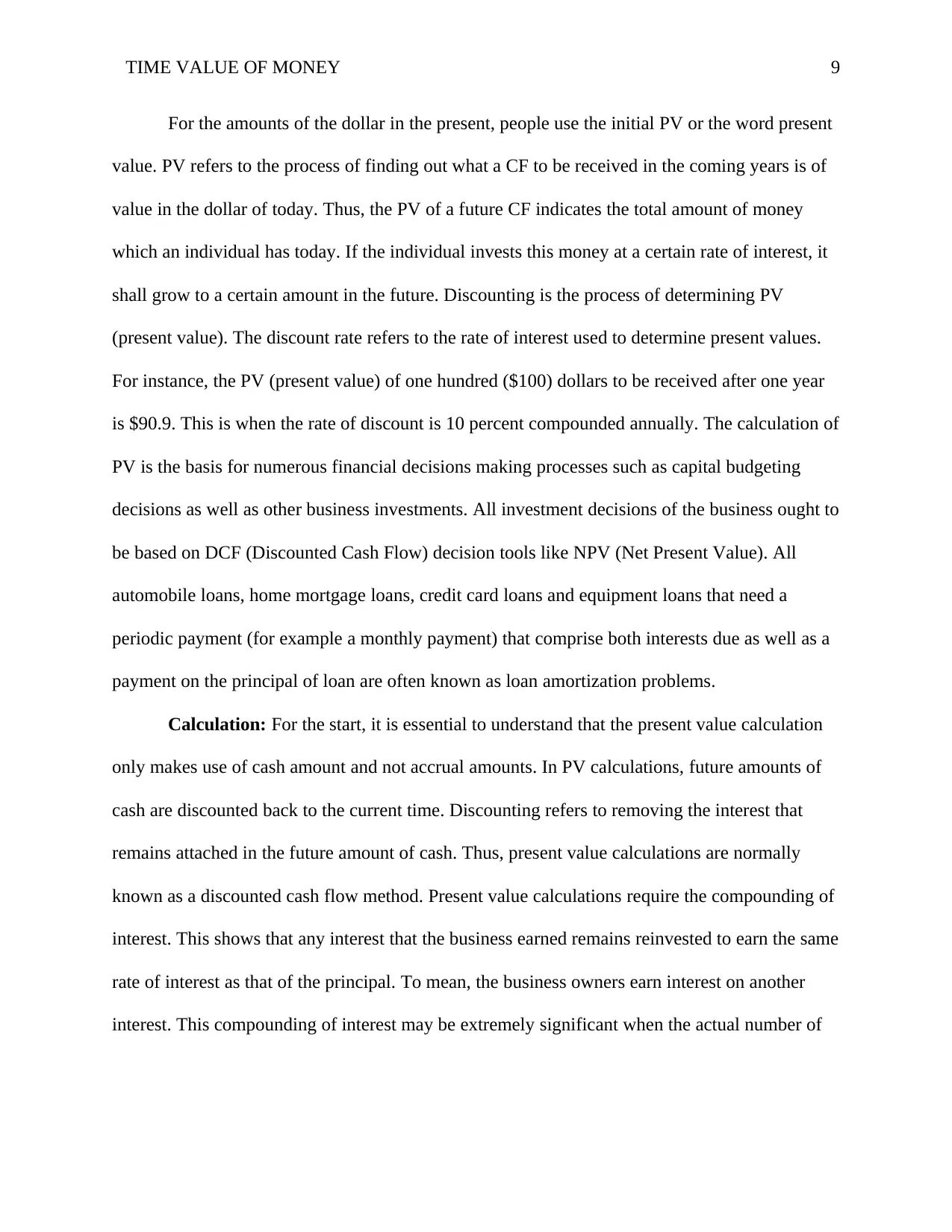
TIME VALUE OF MONEY 9
For the amounts of the dollar in the present, people use the initial PV or the word present
value. PV refers to the process of finding out what a CF to be received in the coming years is of
value in the dollar of today. Thus, the PV of a future CF indicates the total amount of money
which an individual has today. If the individual invests this money at a certain rate of interest, it
shall grow to a certain amount in the future. Discounting is the process of determining PV
(present value). The discount rate refers to the rate of interest used to determine present values.
For instance, the PV (present value) of one hundred ($100) dollars to be received after one year
is $90.9. This is when the rate of discount is 10 percent compounded annually. The calculation of
PV is the basis for numerous financial decisions making processes such as capital budgeting
decisions as well as other business investments. All investment decisions of the business ought to
be based on DCF (Discounted Cash Flow) decision tools like NPV (Net Present Value). All
automobile loans, home mortgage loans, credit card loans and equipment loans that need a
periodic payment (for example a monthly payment) that comprise both interests due as well as a
payment on the principal of loan are often known as loan amortization problems.
Calculation: For the start, it is essential to understand that the present value calculation
only makes use of cash amount and not accrual amounts. In PV calculations, future amounts of
cash are discounted back to the current time. Discounting refers to removing the interest that
remains attached in the future amount of cash. Thus, present value calculations are normally
known as a discounted cash flow method. Present value calculations require the compounding of
interest. This shows that any interest that the business earned remains reinvested to earn the same
rate of interest as that of the principal. To mean, the business owners earn interest on another
interest. This compounding of interest may be extremely significant when the actual number of
For the amounts of the dollar in the present, people use the initial PV or the word present
value. PV refers to the process of finding out what a CF to be received in the coming years is of
value in the dollar of today. Thus, the PV of a future CF indicates the total amount of money
which an individual has today. If the individual invests this money at a certain rate of interest, it
shall grow to a certain amount in the future. Discounting is the process of determining PV
(present value). The discount rate refers to the rate of interest used to determine present values.
For instance, the PV (present value) of one hundred ($100) dollars to be received after one year
is $90.9. This is when the rate of discount is 10 percent compounded annually. The calculation of
PV is the basis for numerous financial decisions making processes such as capital budgeting
decisions as well as other business investments. All investment decisions of the business ought to
be based on DCF (Discounted Cash Flow) decision tools like NPV (Net Present Value). All
automobile loans, home mortgage loans, credit card loans and equipment loans that need a
periodic payment (for example a monthly payment) that comprise both interests due as well as a
payment on the principal of loan are often known as loan amortization problems.
Calculation: For the start, it is essential to understand that the present value calculation
only makes use of cash amount and not accrual amounts. In PV calculations, future amounts of
cash are discounted back to the current time. Discounting refers to removing the interest that
remains attached in the future amount of cash. Thus, present value calculations are normally
known as a discounted cash flow method. Present value calculations require the compounding of
interest. This shows that any interest that the business earned remains reinvested to earn the same
rate of interest as that of the principal. To mean, the business owners earn interest on another
interest. This compounding of interest may be extremely significant when the actual number of
⊘ This is a preview!⊘
Do you want full access?
Subscribe today to unlock all pages.

Trusted by 1+ million students worldwide
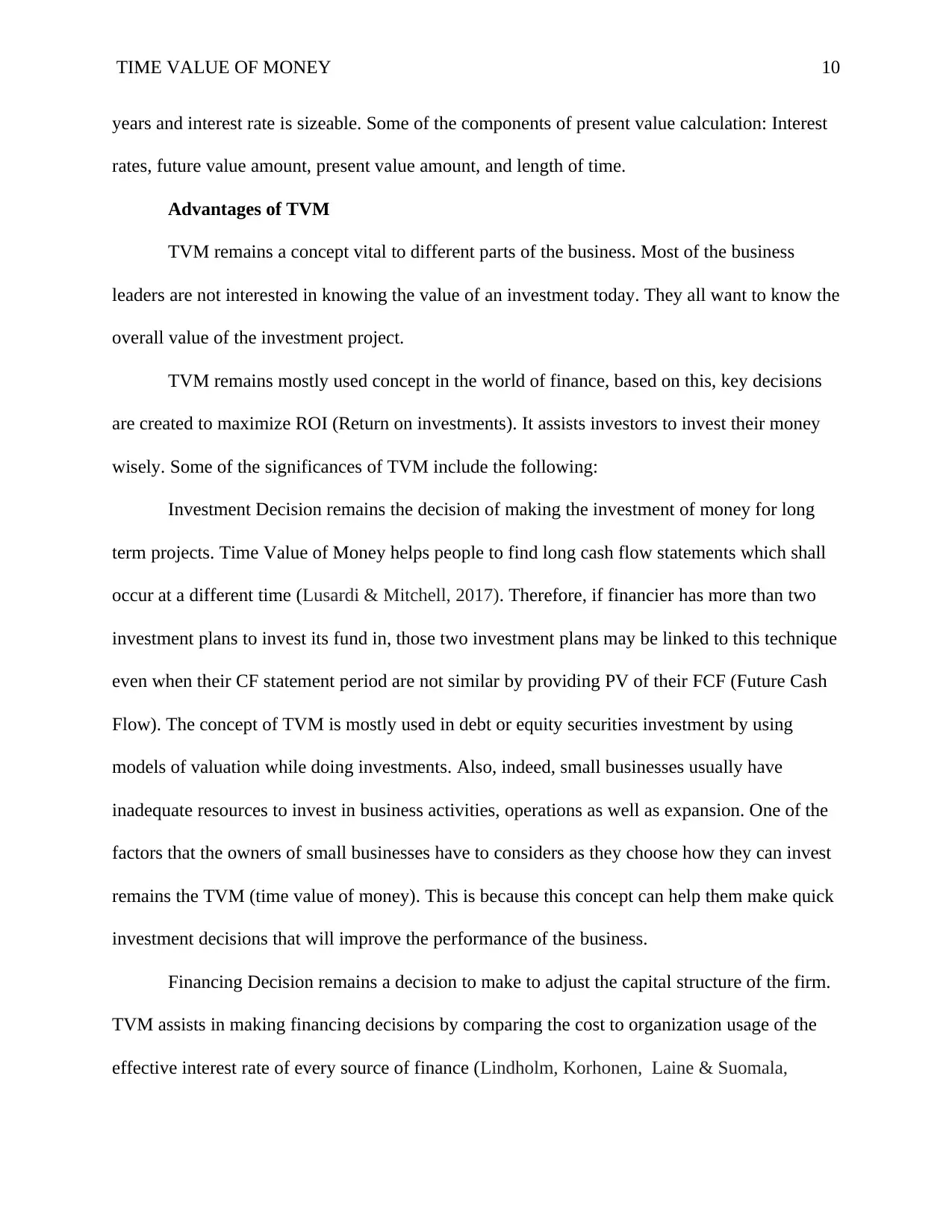
TIME VALUE OF MONEY 10
years and interest rate is sizeable. Some of the components of present value calculation: Interest
rates, future value amount, present value amount, and length of time.
Advantages of TVM
TVM remains a concept vital to different parts of the business. Most of the business
leaders are not interested in knowing the value of an investment today. They all want to know the
overall value of the investment project.
TVM remains mostly used concept in the world of finance, based on this, key decisions
are created to maximize ROI (Return on investments). It assists investors to invest their money
wisely. Some of the significances of TVM include the following:
Investment Decision remains the decision of making the investment of money for long
term projects. Time Value of Money helps people to find long cash flow statements which shall
occur at a different time (Lusardi & Mitchell, 2017). Therefore, if financier has more than two
investment plans to invest its fund in, those two investment plans may be linked to this technique
even when their CF statement period are not similar by providing PV of their FCF (Future Cash
Flow). The concept of TVM is mostly used in debt or equity securities investment by using
models of valuation while doing investments. Also, indeed, small businesses usually have
inadequate resources to invest in business activities, operations as well as expansion. One of the
factors that the owners of small businesses have to considers as they choose how they can invest
remains the TVM (time value of money). This is because this concept can help them make quick
investment decisions that will improve the performance of the business.
Financing Decision remains a decision to make to adjust the capital structure of the firm.
TVM assists in making financing decisions by comparing the cost to organization usage of the
effective interest rate of every source of finance (Lindholm, Korhonen, Laine & Suomala,
years and interest rate is sizeable. Some of the components of present value calculation: Interest
rates, future value amount, present value amount, and length of time.
Advantages of TVM
TVM remains a concept vital to different parts of the business. Most of the business
leaders are not interested in knowing the value of an investment today. They all want to know the
overall value of the investment project.
TVM remains mostly used concept in the world of finance, based on this, key decisions
are created to maximize ROI (Return on investments). It assists investors to invest their money
wisely. Some of the significances of TVM include the following:
Investment Decision remains the decision of making the investment of money for long
term projects. Time Value of Money helps people to find long cash flow statements which shall
occur at a different time (Lusardi & Mitchell, 2017). Therefore, if financier has more than two
investment plans to invest its fund in, those two investment plans may be linked to this technique
even when their CF statement period are not similar by providing PV of their FCF (Future Cash
Flow). The concept of TVM is mostly used in debt or equity securities investment by using
models of valuation while doing investments. Also, indeed, small businesses usually have
inadequate resources to invest in business activities, operations as well as expansion. One of the
factors that the owners of small businesses have to considers as they choose how they can invest
remains the TVM (time value of money). This is because this concept can help them make quick
investment decisions that will improve the performance of the business.
Financing Decision remains a decision to make to adjust the capital structure of the firm.
TVM assists in making financing decisions by comparing the cost to organization usage of the
effective interest rate of every source of finance (Lindholm, Korhonen, Laine & Suomala,
Paraphrase This Document
Need a fresh take? Get an instant paraphrase of this document with our AI Paraphraser
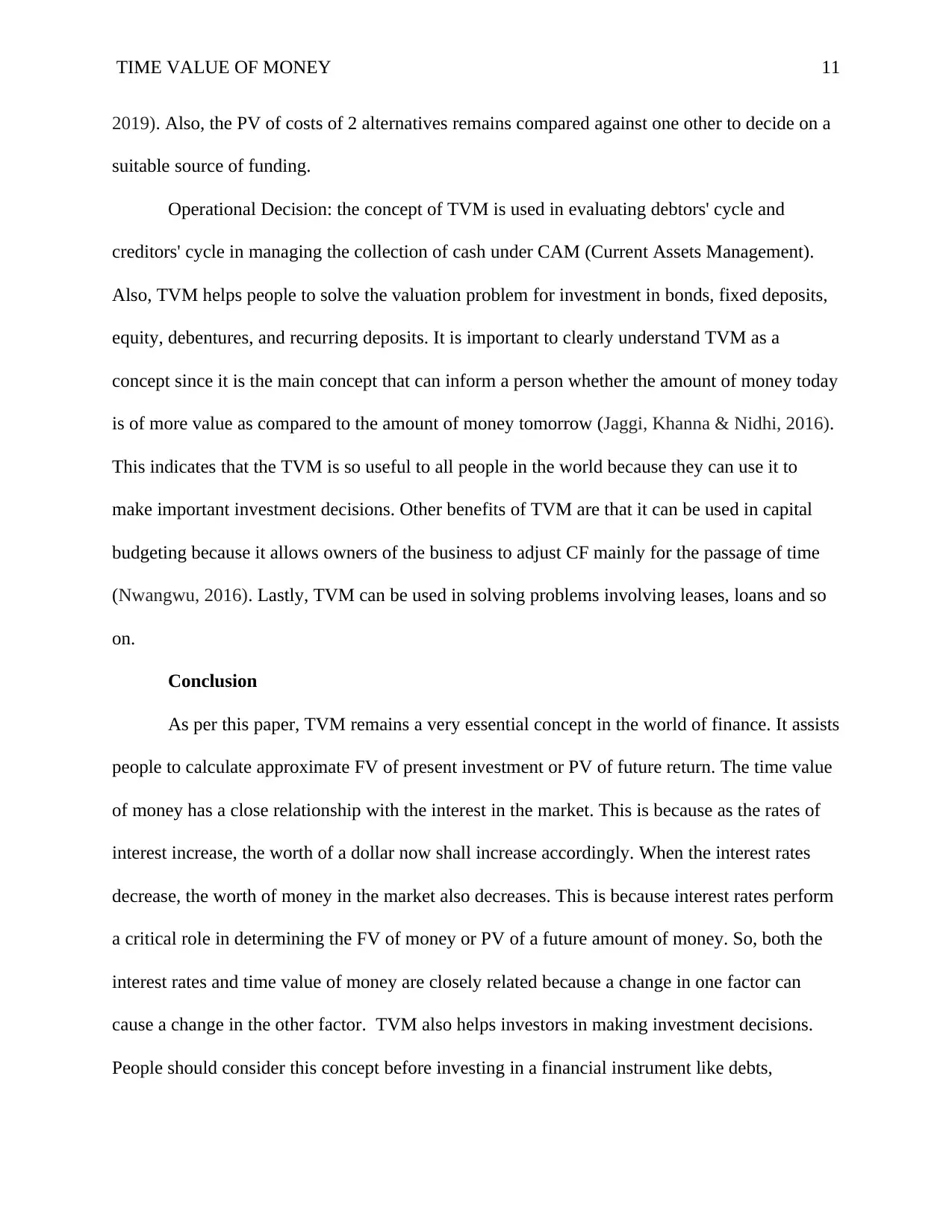
TIME VALUE OF MONEY 11
2019). Also, the PV of costs of 2 alternatives remains compared against one other to decide on a
suitable source of funding.
Operational Decision: the concept of TVM is used in evaluating debtors' cycle and
creditors' cycle in managing the collection of cash under CAM (Current Assets Management).
Also, TVM helps people to solve the valuation problem for investment in bonds, fixed deposits,
equity, debentures, and recurring deposits. It is important to clearly understand TVM as a
concept since it is the main concept that can inform a person whether the amount of money today
is of more value as compared to the amount of money tomorrow (Jaggi, Khanna & Nidhi, 2016).
This indicates that the TVM is so useful to all people in the world because they can use it to
make important investment decisions. Other benefits of TVM are that it can be used in capital
budgeting because it allows owners of the business to adjust CF mainly for the passage of time
(Nwangwu, 2016). Lastly, TVM can be used in solving problems involving leases, loans and so
on.
Conclusion
As per this paper, TVM remains a very essential concept in the world of finance. It assists
people to calculate approximate FV of present investment or PV of future return. The time value
of money has a close relationship with the interest in the market. This is because as the rates of
interest increase, the worth of a dollar now shall increase accordingly. When the interest rates
decrease, the worth of money in the market also decreases. This is because interest rates perform
a critical role in determining the FV of money or PV of a future amount of money. So, both the
interest rates and time value of money are closely related because a change in one factor can
cause a change in the other factor. TVM also helps investors in making investment decisions.
People should consider this concept before investing in a financial instrument like debts,
2019). Also, the PV of costs of 2 alternatives remains compared against one other to decide on a
suitable source of funding.
Operational Decision: the concept of TVM is used in evaluating debtors' cycle and
creditors' cycle in managing the collection of cash under CAM (Current Assets Management).
Also, TVM helps people to solve the valuation problem for investment in bonds, fixed deposits,
equity, debentures, and recurring deposits. It is important to clearly understand TVM as a
concept since it is the main concept that can inform a person whether the amount of money today
is of more value as compared to the amount of money tomorrow (Jaggi, Khanna & Nidhi, 2016).
This indicates that the TVM is so useful to all people in the world because they can use it to
make important investment decisions. Other benefits of TVM are that it can be used in capital
budgeting because it allows owners of the business to adjust CF mainly for the passage of time
(Nwangwu, 2016). Lastly, TVM can be used in solving problems involving leases, loans and so
on.
Conclusion
As per this paper, TVM remains a very essential concept in the world of finance. It assists
people to calculate approximate FV of present investment or PV of future return. The time value
of money has a close relationship with the interest in the market. This is because as the rates of
interest increase, the worth of a dollar now shall increase accordingly. When the interest rates
decrease, the worth of money in the market also decreases. This is because interest rates perform
a critical role in determining the FV of money or PV of a future amount of money. So, both the
interest rates and time value of money are closely related because a change in one factor can
cause a change in the other factor. TVM also helps investors in making investment decisions.
People should consider this concept before investing in a financial instrument like debts,
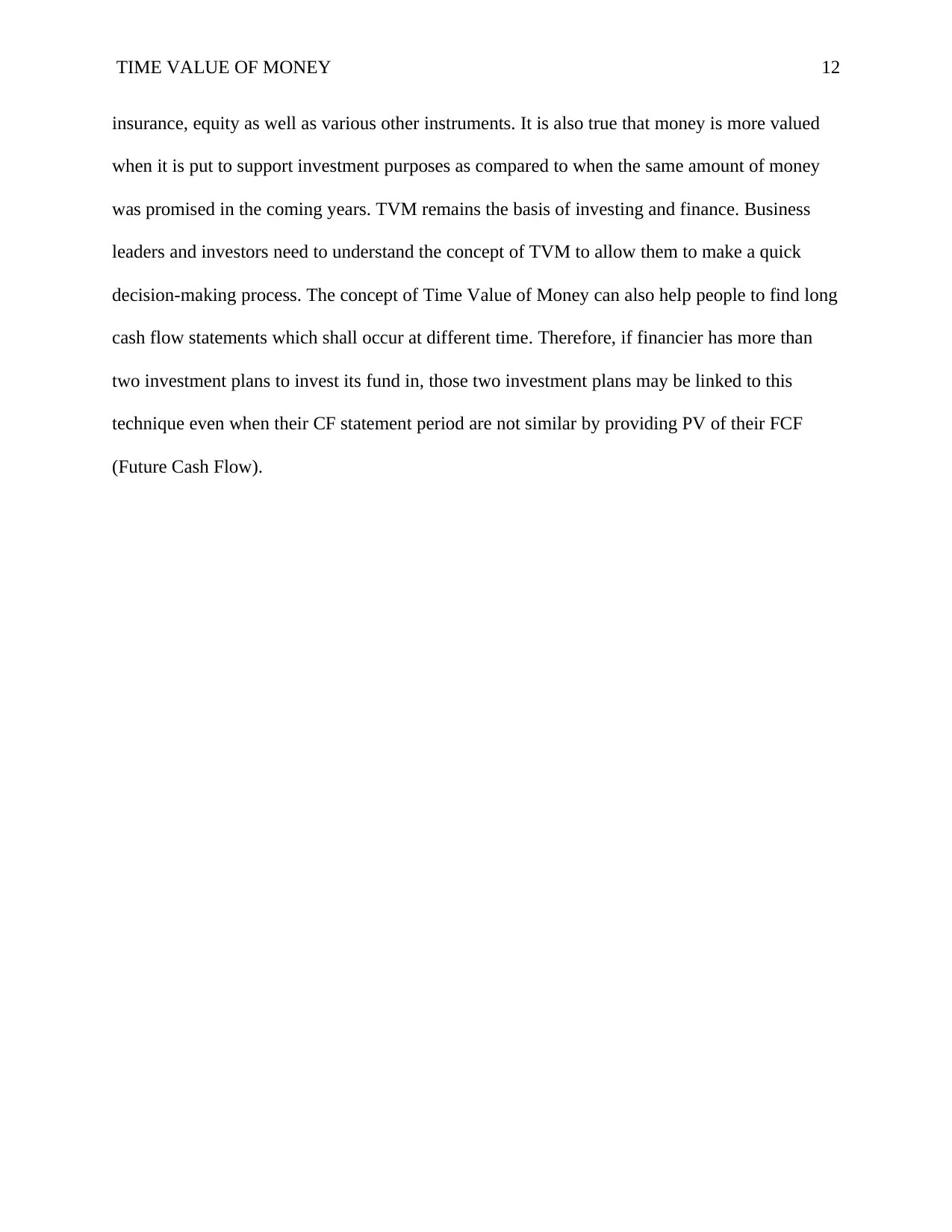
TIME VALUE OF MONEY 12
insurance, equity as well as various other instruments. It is also true that money is more valued
when it is put to support investment purposes as compared to when the same amount of money
was promised in the coming years. TVM remains the basis of investing and finance. Business
leaders and investors need to understand the concept of TVM to allow them to make a quick
decision-making process. The concept of Time Value of Money can also help people to find long
cash flow statements which shall occur at different time. Therefore, if financier has more than
two investment plans to invest its fund in, those two investment plans may be linked to this
technique even when their CF statement period are not similar by providing PV of their FCF
(Future Cash Flow).
insurance, equity as well as various other instruments. It is also true that money is more valued
when it is put to support investment purposes as compared to when the same amount of money
was promised in the coming years. TVM remains the basis of investing and finance. Business
leaders and investors need to understand the concept of TVM to allow them to make a quick
decision-making process. The concept of Time Value of Money can also help people to find long
cash flow statements which shall occur at different time. Therefore, if financier has more than
two investment plans to invest its fund in, those two investment plans may be linked to this
technique even when their CF statement period are not similar by providing PV of their FCF
(Future Cash Flow).
⊘ This is a preview!⊘
Do you want full access?
Subscribe today to unlock all pages.

Trusted by 1+ million students worldwide
1 out of 14
Related Documents
Your All-in-One AI-Powered Toolkit for Academic Success.
+13062052269
info@desklib.com
Available 24*7 on WhatsApp / Email
![[object Object]](/_next/static/media/star-bottom.7253800d.svg)
Unlock your academic potential
Copyright © 2020–2025 A2Z Services. All Rights Reserved. Developed and managed by ZUCOL.





